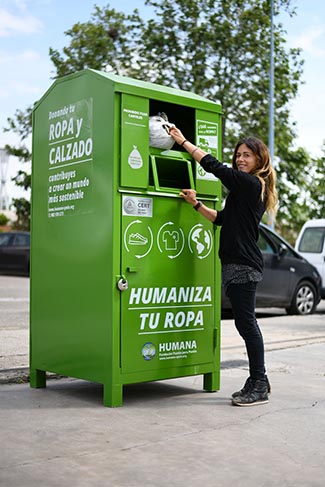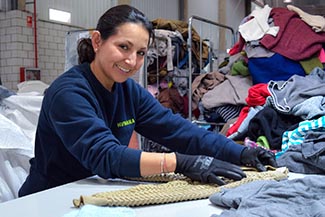consent_cookie
Duración: 1 year
Stores the user's cookie consent state
05-06-2023
The reuse of used clothing is the best way to prevent it from becoming waste, with the environmental and economic expense that the production of a new garment represents to replace the one we do not want. This is corroborated by a study by the European Confederation of Recycling Industries (EuRIC), which ensures that the environmental impact of reusing textiles is 70 times less than the production of new clothing.
Added to this is that for every kg of clothing recovered and not taken to a waste treatment center for incineration or final disposal, the emission of 6.1 kg of CO2 is avoided, according to a study by Humana People to People.
On World Environment Day, which is celebrated this Monday, June 5, at Humana we highlight that the reuse of textiles is key to the circular economy, sustainability and the creation of green jobs, which is why we have been committed to giving a second life to the garments that are not used. Last year we recovered 17,845 tons of used textiles in Spain: equivalent to 72 million garments that have extended their useful life and whose management prevented the emission of 108,855 tons of CO2.
The consumption of clothing has grown disproportionately in the last 15 years, however, the percentage of the correct treatment of that clothing has not increased proportionally when we we get rid of it. It is estimated that each citizen discards between 20 and 30 kg of textiles annually.
In Spain we generate more than one million tons of textile waste per year in our homes, but only 12% is selectively recovered to promote its reuse or recycling; the rest is thrown away in other fractions and ends up in a landfill.
“The selective collection of clothing has a high potential to guarantee a second life: 60% can be reused and more than 30% recycled. That is why it is important that it be deposited in a container of clothes; It is obvious, but almost 90% of the textile waste does not end up at the appropriate collection point”, affirms the director of Projects and External Relations of Humana, Rafael Mas, who recalls that the textile sector generates an enormous demand for raw materials and water, and is one of the sectors that generates the most greenhouse gas emissions.
The sector is hopeful about the effects that the new national and European legislation may have (EU Strategy for Sustainable and Circular Textiles and Law 7/2022, of April 8, on Waste and Contaminated Soils for a Circular Economy), so that waste collection increases and the sector evolves towards a circular model, neutral in emissions, more sustainable and respectful of the environment.
The study by Humana People to People which brings together 29 entities and is present in 46 countries, determines that for every kg of clothing collected selectively, 6.1 kg of CO2 are avoided. For arriving at this figure takes into account the amount of textile waste recovered, the reuse rate of each garment, the replacement rate (in the case of Spain, the replacement rate is 70%, that is, 7 out of 10 customers of Humana stores state that when they buy a second-hand garment they stop buying a new item) and the carbon dioxide emissions that the production of a new garment implies.
The destination of the collected clothes
Humana recovered 17,845 tons of used textiles in Spain in 2022, which is equivalent to 72 million garments. We have two PxR plants (in Leganés -Madrid- and l'Ametlla del Vallès, in Barcelona), increasing the percentage of processed textile destined for reuse with respect to previous years, thanks to the implementation of increasingly specific criteria in the process of classification. Currently, the destination of the classified garments is:
At the samne tiem, European Green Week 2023 will spotlight the European Union policy, biodiversity, circular economy and zero pollution. Side-events and presentations will be delivered by academia, professionals, environmental organizations and government agencies throughout Europe.


